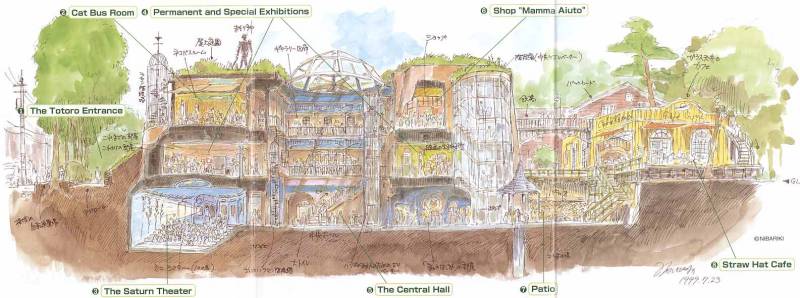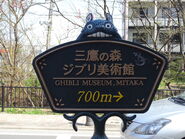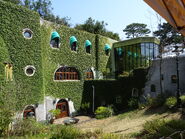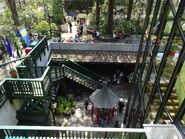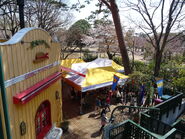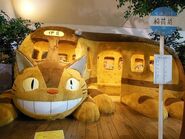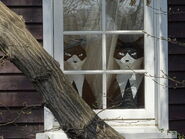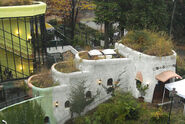The Ghibli Museum of The Forest of Mitaka, otherwise known as the Ghibli Museum (三鷹の森ジブリ美術館 , Mitaka Nomori Jiburi Bijutsukan lit. Ghibli Museum, Mitaka), is an animation museum in Nishien, Inokashira Park in Mitaka City, Tokyo. Its official name is Mitaka Municipal Animation Museum. It was developed by Goro Miyazaki and opened on October 1, 2001.
As the name suggests, many Ghibli-related exhibits are stored and on display. The building itself was designed based on a cross-section sketch by Hayao Miyazaki. Studio Ghibli has also produced short animated films, along with permanent exhibitions such as Film Guru Guru that are viewed exclusively screened in the museum, and many former Ghibli directors have been appointed to oversee the museum, such as Goro Miyazaki.
Since 2007, the Ghibli Museum Library in Mitaka has screened and distributed animated films from around the world, such as The Illusionist (2010) by Sylvain Chomet, Wrinkles (Arrugas, 2011) by Ignacio Ferreras and My Love (2006) by Aleksandr Petrov.
Mission[]
Facility Outline[]
Address[]
In English
- 1-1-83 Shimorenjaku, Mitaka
- Tokyo 181-0013
In Japanese
- 〒181-0013 東京都三鷹市下連雀1丁目1−83
Rules[]
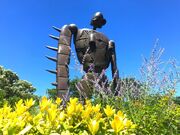
The rooftop garden is one of the few places guests can take photos. The area contains the robot and the Laputian control stone from Castle in the Sky.
Besides the rooftop and outdoor areas, photography is generally prohibited within the museum (it was possible shortly after the museum opened until December 2001, but was banned in 2002). Additionally, smoking has been prohibited on the premises since October 1, 2005.
In 2020, due to the pandemic, new rules were set in place for visitors of the museum.
- If visitors have a fever of 37.5 degrees of Celsius or higher, museum staff have the right to refuse admission. If visitors are suspected of having close contact with a person who is positive for a new coronavirus infection, or if you are suspected of being infected with a family member, they are discouraged from visiting.
- Access to the exhibition room and shops may be restricted due to congestion.
- Guests are asked to bring a handkerchief as there no paper towels are installed in the premises.
- Guests are allowed to bring in a water bottle to rehydrate.
Directors[]
The first director of the museum is Goro Miyazaki. Kiyofumi Nakajima was later appointed as the second director of the museum on June 24, 2005 (Nakajima would later be promoted to president of Studio Ghibli 2017). On November 28, 2017, Kazuki Ansai was appointed as the third director of the museum.
Admission[]
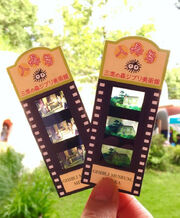
Each ticket holder is given a short film strip from a random Studio Ghibli movie.
Tickets to the Ghibli Museum are only accepted if bought in advance. These reserve tickets can be purchased outside Japan in Hong Kong, Taiwan, Korea, North America, Europe, and Australia, and on internet by LAWSON Ticket Online Shop.
Tickets range from ¥1,000 for adults aged eighteen and above to ¥700 for ages fourteen to eighteen years old, ¥400 for ages seven to thirteen years old, and ¥100 for ages four to six year olds. Ages three years old and under are free. At the museum's entry, the reserve tickets are exchanged for a 35mm film strip that features a scene from one of the Studio Ghibli films.[1][2][3]
- 18+ years - ¥1,000
- 14-18 years - ¥700
- 7-13 years - ¥400
- 4-6 years - ¥100
- 0-3 years - Free
- Admission time is conducted four times a day, from 10, 12, 14 to 16:00. Admission is 30 minutes after the designated ticket time.
- Straw Hat Café opens at 11:00 a.m. and last orders can be placed by 6:00 p.m.
Purchase Options[]
You can buy tickets online, in the US or in Japan:
- Online: Lawson Ticket
- USA: JTB Offices
- Japan: Lawson Store (jap.)
Features[]
Permanent Exhibitions[]

Part of the permanent exhibit called, A Boy's Room - A Gift from Gramp. One of the five rooms on the first floor called Where a Film is Born.
On the bottom floor is an exhibit room showing the history and science of animation, including a three-dimensional zoetrope named Bouncing Totoro, with models of characters from My Neighbor Totoro (1988). Also included is an exhibit for a projector called Film Guru Guru. On the first floor is a mock-up of an animation studio. Called Where a Film is Born, the five-room exhibit is meant to showcase the creative process of an animation filmmaker such as illustration techniques. Packed with books and toys, the room also displays drawings and illustrations that cover the walls. Another exhibit demonstrates the process of creating an animated film, with sketches, storyboarding, keyframing, cleanup, coloring and background painting.
Tri Hawks[]
Tri Hawks is a reading room and bookstore in the Ghibli Museum. Opened on February 6, 2002, it is filled with books recommended by Hayao Miyazaki. "Mi-taka," the city where the Ghibli Museum is located, means three hawks. The name Tri Hawks comes from a pun based on the city's name.
Mamma Aiuto[]
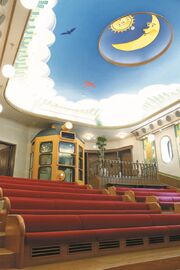
The Saturn Theater is located in the basement of the museum and can seat 80 people.
Mamma Aiuto, on the top of the Ghibli Museum, is the souvenir gift shop named after the band of sky pirates in the movie Porco Rosso.The name Mamma Aiuto translates to "mama, help me" in Italian, which was where Porco Rosso was set. Among other items, it sells classic and non-Japanese animation movies under the eponymous Ghibli Museum Library label.
Straw Hat Café[]
The Straw Hat Café is the Ghibli Museum's only sit-down restaurant. It was created with the help of a housewife who is a mother of four; Miyazaki wanted the café's food to be "a kind of home cooking". The Café serves hot and cold foods, snacks, and desserts. Sold at the takeout section is an original alcoholic beverage: Valley of the Wind beer. The beer was created by a collaboration with Dairy Kingdom Oratche, a microbrewery in Tanna Basin. The beverage's label was hand drawn by Goro Miyazaki, Hayao Miyazaki's son, who is an animation director at Studio Ghibli as well.[4]
Catbus Room[]
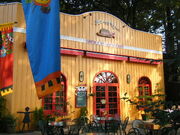
The Straw Hat Café allows guests to enjoy the outdoor atmosphere of Inokashira Park. The menu is simple and the variety is limited, but almost everything comes from organic farms.
There is a playroom for children age 12 and below with a giant Catbus toy to play in. In order for the Catbus to fit in the museum it had to be downsized from the original film scale as seen in My Neighbor Totoro (1988).
Rooftop Garden[]
On the museum's roof is a garden with a life-size, five meter tall statue of a robot from the final episode of Lupin III Part II and Laputa: Castle in the Sky.[5] The Robot Soldier was made by the artist Kunio Shachimaru. The statue is formed from hammered copper plate and took 2 years to create. The keystone from the movie Castle in the Sky can be found here. The keystone, bearing an inscription in Old Persian cuneiform, is a replica of the control room stone found in the floating castle, Laputa, in the movie Laputa: Castle in the Sky.
Fresco Painting[]
At the entrance of the building, the museum's ceiling is covered in a fresco painting. The painting features characters from the Studio Ghibli films such as Kiki on her broomstick from the film Kiki's Delivery Service (1989).
Special Exhibitions[]
In addition to Ghibli-oriented exhibitions, the museum hosts an area showcasing work from other studios.
| Date | Exhibit |
|---|---|
| 2001–2002 | Spirited Away |
| 2002–2004 | Laputa: Castle in the Sky and Imaginary Flying Machines |
| 2003–2004 | Works by the Russian animator Yuri Norstein |
| 2004–2005 | Pixar Animation Studios |
| 2005–2006 | Heidi, Girl of the Alps |
| 2006–2007 | Aardman Studios, primarily focused on their work on Wallace and Gromit. |
| 2007–2008 | Goldilocks and The Three Bears (3びきのくま Sanbiki no kuma) , based on a picture book version by Leo Tolstoy. Panda! Go, Panda!, one of Miyazaki's and Isao Takahata's early, pre-Ghibli films from 1972.[6] |
| 2008–2009 | Petit Louvre |
| 2009–2010 | Ponyo on the Cliff by the Sea |
| 2010–2011 | Ghibli Forest Movies — Welcome to Saturn Theater |
| 2011–2012 | The View from the Cat Bus[9] |
| 2012–2013 | The Gift of Illustrations ― A Source of Popular Culture[10] |
| 2013–2014 | The Lens at Work in The Ghibli Forest[11] |
| 2014–2015 | The Nutcracker and the Mouse King ― A Fairy Tale Treasure |
| 2015–2016 | The Haunted Tower ― Perfect Popular Culture[12] |
Short Films[]
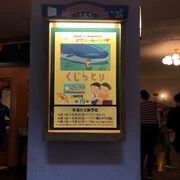
The short films shown in the Saturn Theater changes throughout the year. A poster is displayed featuring the film for the day.
The Ghibli Museum shows twelve short films exclusive to the Ghibli museum. Located in the basement of the museum is The Saturn Theater. The theater has windows where automated shades lower and open before and after each showing of its short films. This is because Hayao Miyazaki designed the theater with small children in mind, who could possibly be scared of the closed in theater. The museum shows one of the following Ghibli short-films in the Saturn Theatre:[13]
- Koro's Big Day Out (コロの大さんぽ Koro no dai-sampo) - The puppy Koro rushes out of the house chasing Sawako leaving for school, but Koro gets lost. In unfamiliar places, Koro is nearly run over by a car, threatened by an alley cat... For little Koro, everything he encounters outside is new and a big adventure. Meanwhile, Sawako comes home to learn that Koro is gone. She frantically tries to find him.
- Water Spider Monmon (水グモもんもん Mizugumo Monmon) - Mon Mon the water spider swims back and forth to the water surface every day to get bubbles of air. One day, Mon Mon meets a damsel water strider who is freely gliding on the water surface. Mon Mon falls in love. On lonely nights in the swamp, all he can think about is the water strider. Is there any chance that his love will be answered?
- Mei and the Kittenbus (めいとこねこバス Mei to Konekobasu) - Mei is eating a caramel on one very windy day, when suddenly a whirlwind appears and starts chasing her. The whirlwind turns out to be a baby cat bus. Mei offers the kitten a caramel and the two become friends. That night, the baby cat bus visits Mei. Letting Mei ride inside him, he leaps out into the sky. They head for the midnight forest full of ghosts. Other cat buses large and small have also gathered together. In the forest, Mei encounters...
- The Day I Harvested a Star (星をか��た日 Hoshi o Katta Hi) - In the city where Nona lives, the Time Bureau watches how its citizens use time. The Bureau supervises those who are wasting time or using time incorrectly. Nona is unable to bear this and runs away from home. He meets a mysterious woman named Ninya, and begins life on her farm. One day, Nona obtains a seed of a star in exchange for his vegetables, and decides to row it.
- The Whale Hunt (くじらとり Kujiratori) - Shigeru is a little boy who goes to the Tulip Nursery School. One morning at school, Shigeru sees the boys a year older building a ship with blocks. He wants to join in too. The completed ship is named the Elephant and Lion. Soon, the children realize the surroundings have transformed into a sea, and even fishes are swimming. The boys load fishing rods and ropes onto the Elephant and Lion, and set out on a whale hunt.
- Looking for a Home (やどさがし Yadosagashi) - Fuki packs all her needs in a big rucksack, and sets out on a journey to look for a new house. After going through the car-jammed city, she finds a stone Jizo statue on an old, narrow path. Fuki places an apple as an offering to ask for passage and walks on. On her way, she encounters the river guardian Nurari-Hyotan, the shrine guardian Ushi-Oni, and other strange creatures one after another. What will Fuki do now?
- A Sumo Wrestler's Tail (ちゅうずもう Chūzumō) - Once upon a time, deep in the mountains, there lived an old couple who worked day after day in exhaustion, toiling up and down the mountain field. One night, the old man stepped outside and noticed a group of mice headed somewhere. He quietly follows them to find mice gathered for a sumo tournament. When the old man and his wife learn that their home mice are always losing, they start preparing a special feast of saury fish dumplings and grilled tofu with miso sauce. They even make new red sumo uniforms for their mice team. What will happen in the next sumo games?
- Mr. Dough and the Egg Princess (パン種とタマゴ姫 Pan dane to tamago hime) - In a lonesome water mill deep in a forest of briers and brambles lives a witch named Baba Yaga. There the witch keeps her servant the Egg Princess confined and forces the tiny egg-girl to do all the hard daily chores around the mill. One night, a large batch of kneaded dough resting in a trough suddenly comes to life from the witch's spell. Fearful of the witch, the Egg Princess and her new friend decide to run away. What will lay ahead for the two of them...?
- Treasure Hunting (たからさがし Takara Sagashi) - A boy named Yuji and his friend Gick, a rabbit, find a walking stick. To decide which of them will keep it, they try a foot race, a long jump and sumo wrestling, but each ends up in a tie. Out of ideas, the children go to Gick's Granny for help. Granny tells the children to go treasure hunting. Who will be the winner?
- Boro the Caterpillar (Kemushi no Boro) - Just before dawn, Boro the Caterpillar hatched from an egg among patches of scrub grass. Looking around for the first time in fascination, he noticed the brilliance of the morning sun and a deliciousness in the air. As the sun lights up the grove, the borogiku (groundsel) leaves began to photosynthesize. "The air and water taste great!" Boro stepped out into the world of caterpillars' friends and foes.
Each guest to the museum is only permitted to watch the short film once during a single visit.
Map[]
History[]
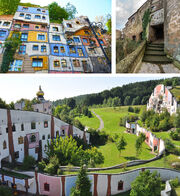
The unique architecture of Viennese artist Hundertwasser and the narrow streets of Calcata, Italy inspired Miyazaki.
Planning for the museum began in 1998. Construction started in March 2000, and the museum opened October 1, 2001.[14] Studio Ghibli director Hayao Miyazaki designed the museum himself, using storyboards similar to the ones he creates for his films. The design was influenced by European architecture such as the hilltop village of Calcata in Italy. Calcata is described as a "very typical Italian borgo, or hill town. Built on crags for defense in the turbulent Middle Ages, these settlements began to decline and lose their populations over the course of the twentieth century."[15] The narrow, winding streets leading to unexpected places perfectly captured the museum's design ethos.
In the 2005 documentary Ghibli et le mystère Miyazaki, Goro Miyazaki, who was the administrator of the museum at the time, explained the maze-like nature of the building reflected his father's films in transporting viewers to another world, and having them guess what will come next.
In Steve Alpert's autobiography, Sharing a House with the Never-ending Man, he pointed out a trip to Vienna that their distributor Miramax had arranged to convince Hayao Miyazaki to attend the Berlin Film Festival. Miyazaki had taken a particular interest in the architecture of Hundertwasser, and they had planned to visit several of his buildings around Austria.
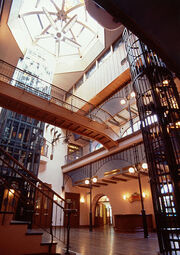
The central hall of the museum, inspired by Miyazaki's trips to Italy and parts of Europe.
Alpert described it as such, "They were colorful, undulating structures that stood out for their surroundings and added a lively sense of fun and color to otherwise orthodox neighborhoods of standard European fine architecture. The Hundertwasser buildings incorporated vegetation of trees and grass into their designs and into the buildings themselves and had uneven floors and irregularly shaped rooms and mosaic-tiled exteriors."[16]
The museum features internal and external spiral staircases built from iron, interior bridges, and balconies stretching throughout the building's height. These stairways lead to exhibits, dead ends, and across bridges. A mural called Upward Draft by Naohisa Inoue can also be found in this area. These characteristics are meant to reflect Miyazaki's building designs displayed in his film work.[17]
Miyazaki's aim was to make the building itself part of the exhibit,[18] and for the museum to be an uplifting and relaxing experience "that makes you feel more enriched when you leave than when you entered". The museum is described as a "portal to a storybook world." Hayao Miyazaki's goal was also for people to experience the museum with their own eyes and ears. "Let's get lost together" is the museum's slogan, derived from Hayao Miyazaki's vision for visitors to immerse themselves in his imagination and film work.[19] In 2020, US$200,000 was raised to save the museum.[20]
Hayao Miyazaki and the Ghibli Museum[]
"Congratulations, Miya-san. The Ghibli Museum of Art in Mitaka is interesting. This is a new achievement for Hayao Miyazaki, comparable to Totoro's birth."
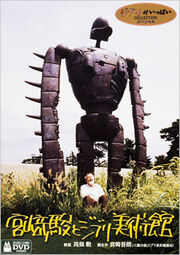
DVD cover of the documentary with Yuri Norstein resting underneath a Laputan robot.
Hayao Miyazaki and the Ghibli Museum (宮崎駿とジブリ美術館 , Miyazaki-shun to Jiburi Bijutsukan) is a 2005 documentary directed by Junichi Sato (director of A Whisker Away, 2020) about the Ghibli Museum. It features Goro Miyazaki speaking with Isao Takahata about the "charm" of the museum and its various influences. Goro tours the viewer around the museum, explaining the intricate details that his father, Hayao Miyazaki made during its construction.
The documentary highlights the strong European influences in the museum's architecture, featuring footage of the medieval mountainous city of Calcata in Italy and the historic port city of Genoa, which Miyazaki had visited in the past. These trips would go on to influencing the imagery seen in Castle in the Sky, Kiki's Delivery Service, Porco Rosso, and Spirited Away.
Highlights[]
- Guided tour of Ghibli Museum, Mitaka "Let's get lost, together." (about 15 Min)
- Interview with director John Lasseter (about 26 minutes)
- Interview with director Yuri Norstein (about 26 minutes)
- Photo gallery “A trip to Italy” (Photography: Chieko Tamura)
- Released on March 18, 2005, and sold for ¥3,800.
Credits[]
| Credit | Staff |
|---|---|
| Planning | Goro Miyazaki |
| Composition/Director | Juichi Sato |
| Photography | Takashi Seki, Chieko Tamura |
| Editor | Yoshiko Saito |
| Production | TV Man Union |
| Production Cooperation | Ghibli Museum, Mitaka (Tokuma Memorial Animation Culture Foundation), Studio Ghibli |
Easter Eggs[]

Directors made their mark in the projection room at the Saturn Theater.
- The building contains hidden imagery from various Pixar films such as Toy Story and Finding Nemo.
- The Cat King's bodyguards from The Cat Returns can be seen through a window.
- Signatures of various directors such as John Lasseter can be found in the projection room in the Saturn Theater. Lasseter himself drew Woody and Buzz Lightyear.
- A DVD featuring footage within the museum, which included Hayao Miyazaki, was released in 2012.
Gallery[]
References[]
- ↑ The Australian, "Celebrating Japanese animation."
- ↑ Online ticket information on Ghibli Museum.
- ↑ Japan Guide on Ghibli Museum ticket acquisition.
- ↑ Ghibli Museum’s Straw Hat Cafe is offering “Valley of the Wind” beer
- ↑ The official site of Ghibli Museum, Mitaka in Japan
- ↑ Ghibli Museum history.
- ↑ Ghibli Museum on "Petit Louvre" special exhibition.
- ↑ Archive of Ghibli Museum special exhibition on "Ponyo".
- ↑ Ghibli Museum profile on Cat Bus exhibition.
- ↑ The Gift of Illustrations ― A Source of Popular Culture" Exhibition
- ↑ Ghibli Museum on "Lens at Work" special exhibition.
- ↑ RocketNews24 on "Ghost Tower" special exhibition.
- ↑ Ghibli Museum Cinema welcome page.
- ↑ Miyazaki, Hayao; Isao Takahata (2009). Starting Point 1979–1996. Viz Media. pp. 446–447. ISBN 978-1-4215-0594-7.
- ↑ Italy Heaven on Calcata.
- ↑ "Sharing a House with the Never-ending Man" by Steve Alpert, pp84
- ↑ The official site of Ghibli Museum, Mitaka in Japan - This is the Kind of Museum I Want to Make!".
- ↑ Isao Takahata, Goro Miyazaki (2005). 宮崎駿とジブリ美術館 (Hayao Miyazaki and Ghibli Museum) (DVD). Japan: BVHE Japan.
- ↑ The Continuing Allure of Hayao Miyazaki': Celebrating Japanese Pop Culture". The Stanford Daily. The Stanford Daily.
- ↑ https://kotaku.com/over-200-000-raised-to-help-save-the-studio-ghibli-mus-1847317634
External links[]
- Official Webpage
- Map
- SoraNews24, field report, retrieved February 8, 2015
- Ghibli Museum's Mission
[]
| |||||||||||||||||||

